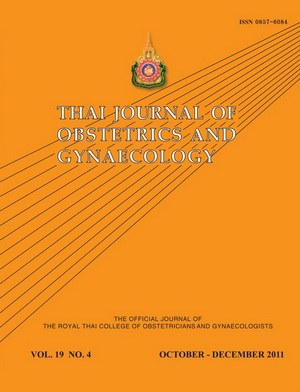Mode of Delivery at Siriraj Hospital: A Ten-Year Review (2001-2010)
Main Article Content
Abstract
Objective: To study mode of delivery and trend of cesarean section, indication of operative delivery and maternal and perinatal mortality at Siriraj Hospital for 10-year period (2001-2010)
Material and Method: The medical records of mode of delivery, indication and maternal and perinatal mortality at Siriraj Hospital during 2001-2010 were collected and analyzed.
Results: During 10-year period, the birth was decreased from 9,555 cases in the year 2001 to 8,853 cases in the year 2010. The rate of single spontaneous vaginal delivery was decreased steadily from the year 2001 (67.1%) to 2010 (53.8%) while the rate of low transverse cesarean section was increased from the year 2001 (27.9%) to the year 2010 (44.5%). The rates of low forceps operation, vacuum extraction and birth before arrival were all decreased steadily from the year 2001 to the year 2010, (forceps operation: 2.99% to 0.44%, vacuum extraction: 8.79% to 2.74%, birth before arrival: 1.1% to 0.05%). Perinatal mortality rate (/1,000 births) after abdominal delivery was continued decreased from the year 2001 (2.4%) to 2006 (0.7%), then increased from the year 2007 (1.4%) to 2010 (2.9%). Perinatal mortality rate (/1,000 births) after vaginal delivery was not changed from the year 2001 (0.94%) to 2010 (0.56%).
Conclusion: The cesarean rate has continued increased while spontaneous vaginal delivery was decreased during the last 10 years. Cesarean section without definite indication must be concerned because the complication and uneventful evidence might be reduced.


